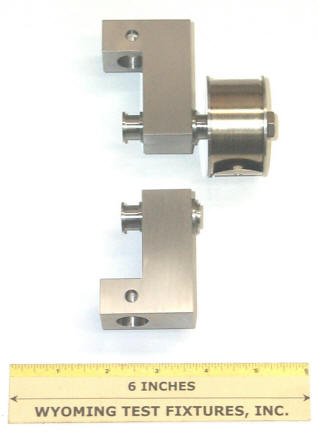Rubber O-Ring Test Fixture (ASTM D1414)
Model No. WTF-RO (Stainless Steel)

Fig. 1: Disassembled fixture without specimen installed
ASTM Standard D1414 (Reference 1) defines a procedure for determining the physical properties of O-rings, and changes in these properties due to aging. A fixture consisting of two pulleys is used to stretch the O-ring to failure. The standard does not define a specific test fixture configuration. However, it does require that one spool must rotate one full revolution for each 6“ of travel of the grips, to minimize local stresses induced in the specimen due to frictional forces as it is stretched while in contact with a spool. A fixture that meets this requirement is shown in Fig 1.
The upper and lower fixture halves are pinned to a mechanical testing machine. The two small spools on the left side engage the O-ring. These spools are mounted on ball bearings to minimize friction. The large pulley on the right side is a constant force spring. The free end (visible in the photograph) attaches to the base of the testing machine. Attached to the same shaft as the upper spool, it turns one revolution for each 6 in. of travel of the testing machine, turning the upper spool as well, as required. Since it is a constant (7 lb.) force spring, its contribution to the force measured by the testing machine can readily be subtracted out.
Both tensile strength and ultimate elongation are determined.
Source of Additional Information:
1) ASTM Standard D1414-94 (1994; reapproved 2003), "Standard Test Methods for Rubber O-Rings," American Society for Testing and Materials, West Conshohocken, Pennsylvania (originally published in 1956).

